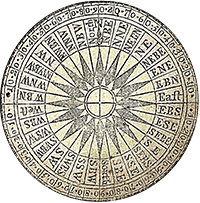The Siege of Fort Wayne.
In early fall of 1812, war became real at Fort Wayne Indiana. The military garrison at Fort Wayne stood to defend themselves from a week long siege by the Pottawatomie and Miami Indians.
The fort was originally erected in 1794 by Major General Anthony Wayne. In the years leading up to The War of 1812, the fort had fallen into disrepair.
The fort’s commander, Captain James Rhea was an experienced member of Wayne’s forces. He took command in spring of 1810 and noted that the garrison was often insubordinate. At that time, Rhea also noted that the fort’s inhabitants’ tendency for drunkenness, lamenting the behavior as an “abominable practice” and stating that he was ” hurt to see so much intoxication”.
Rhea eventually fell to the wiles of alcohol. By 1812, he was described as “a slave to alcohol”. However, before succumbing to temptation, Rhea had substantial repairs to the fort completed and put a sanitation system in place.
The fort first received word that Fort Dearborn fell at the end of August, when a soldier that had escaped the massacre reported in. Immediately following, a trader, Stephen Johnston was killed. Stephens brother and Federal Indian Agent, John Johnston sent Captain Logan to evacuate the local women and children across the Ohio border.
Early on September 5, 1812, warriors from the Pottawatomie and Miami Indians surrounded Fort Wayne. At that time the fort was garrisoned by approximately 70 soldiers and some civilians. Captain James Rhea sent letters to Federal Indian Agent John Johnston and Ohio’s Governor RJ Meigs to ask for assistance. Rhea also invited Indian delegates into the fort to discuss peace. That effort failed. Johnston and Meigs promptly informed Harrison of the situation.
The tribes assaulted the fort from the east side and burned the homes of the surrounding village. Captain Rhea, who by this time was a heavy drinker, was described as taking to drink at the moment of the siege impending, and was said to be “drunk as a fool, and ill treating everyone that came in his presence”.
Because his officers considered placing him under arrest. Rhea retreated to his quarters stating that he was ill and needed relieved. The fort’s Indian Agent, Benjamin Stickney, took command of the fort. Two assaults were made before the Native American force withdrew.
That evening, Chief Winamac approached the fort with thirteen of his men under the guise of talking peace. They were admitted to the fort. This resulted in a failed attempt on Stickney’s life and ended all talks.
Soon after, the Indians resumed their assaults on the exterior of the fort. The Pottawatomie forces tried to set the fort on fire, and while the garrison attempted to keep the walls wet and return fire with muskets and cannon. Eventually the Native American forces retreated to a safe distance from the fort… and continued the attack later that night.
Kentucky Governor Charles Scott appointed General Harrison as Major General of the Kentucky Militia and authorized him to relieve Fort Wayne. Harrison organized a militia force of 2,200 men and marched north. Captain Logan arrived at Fort Wayne during a lull in the fighting, and delivered the news that a relief effort was approaching.
Some of the Ohio Militia members were critical of Harrison’s choice of Kentucky Militia rather than the Ohio Militia. The Kentucky Militia was more than 20 years older than Ohio’s Militia. Harrison chose the Kentuckians because their Militia was more mature and experienced.
Harrison also received a report that a force of 400 Native Americans and 140 British regulars under Tecumseh were marching towards Fort Wayne. Harrison raced to arrive at Fort Wayne before Tecumseh and the British. By 8 September, Harrison and his backup of 2,200 troops had reached the St. Marys River. There they were joined by 800 men of the Ohio militia under Colonel Adams and Colonel Hawkins at Shane’s Crossing.
On September 1th, a final attack on Fort Wayne proved unsuccessful. Harrison’s relief army arrived on September 12th. The Native American and British force retreated into Ohio and the Michigan Territory.
Welcome to “Sharing the Stories of History with Tim Mann”!
Meet Timothy A. Mann, a passionate historian born and raised in the heart of Shelby County, Ohio where Tim’s roots run deep in the rich soil of American history. As the author of articles and books, including “Frontier Miscellany Concerning the Miami County Ohio Militia,” “Colonel John Mann, His Kith and Kin,” and “Frontier Militia – The War of 1812,” Tim’s literary contributions have enlightened and inspired countless history enthusiasts.






